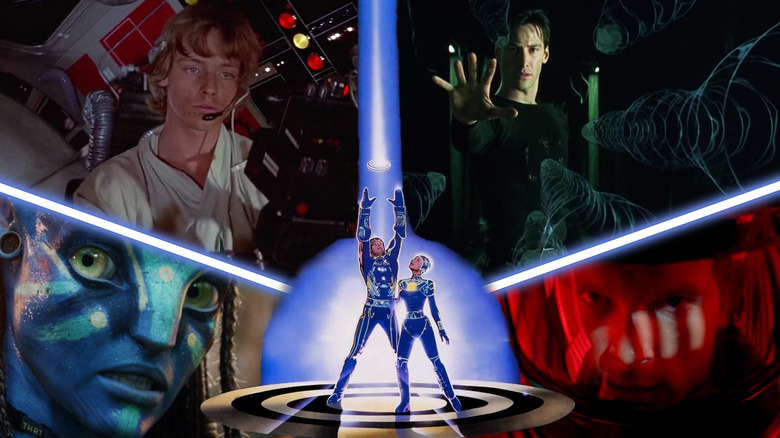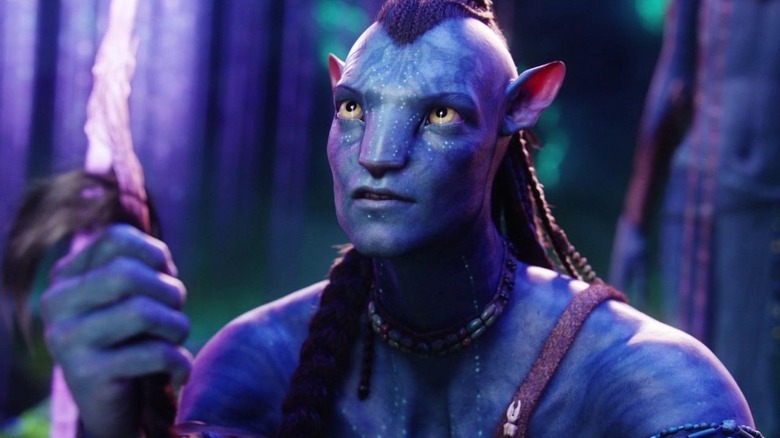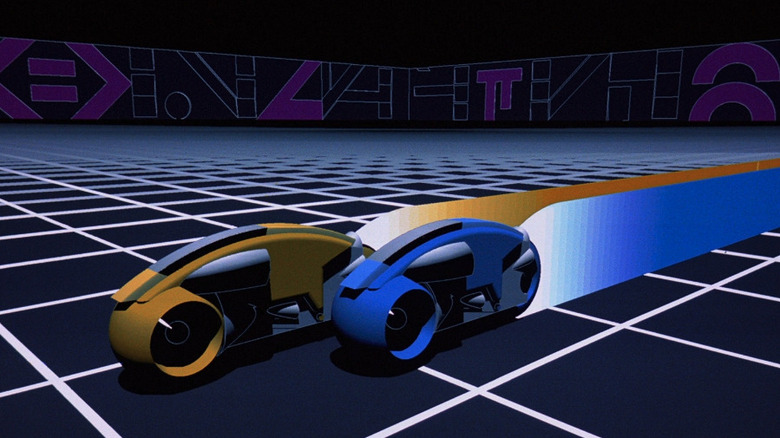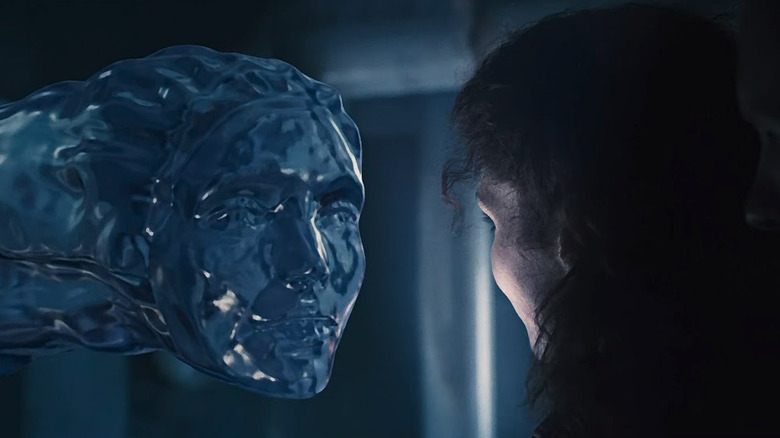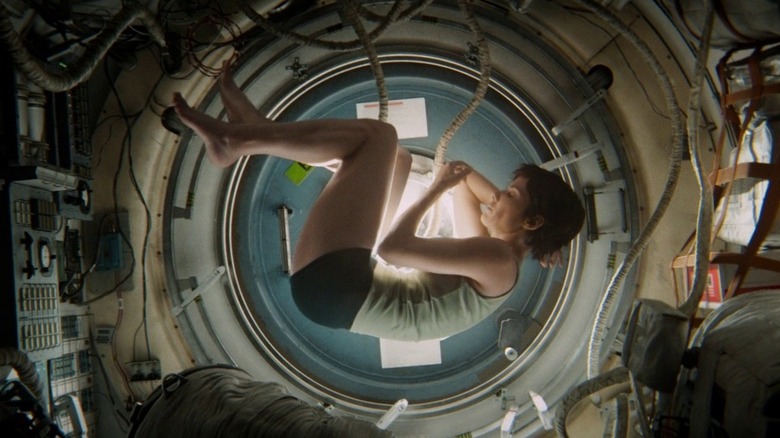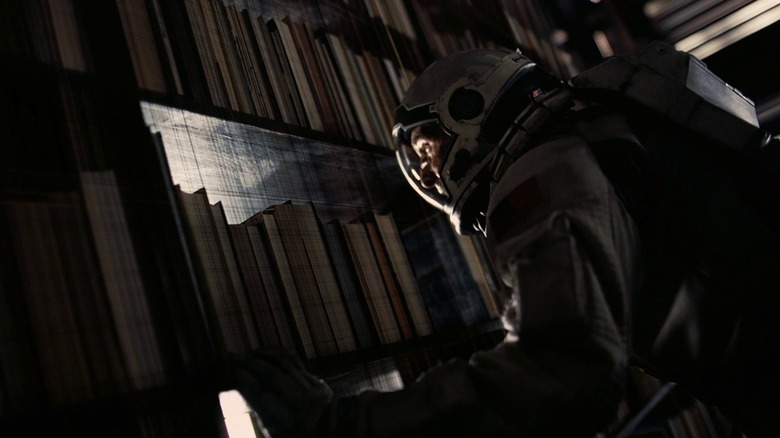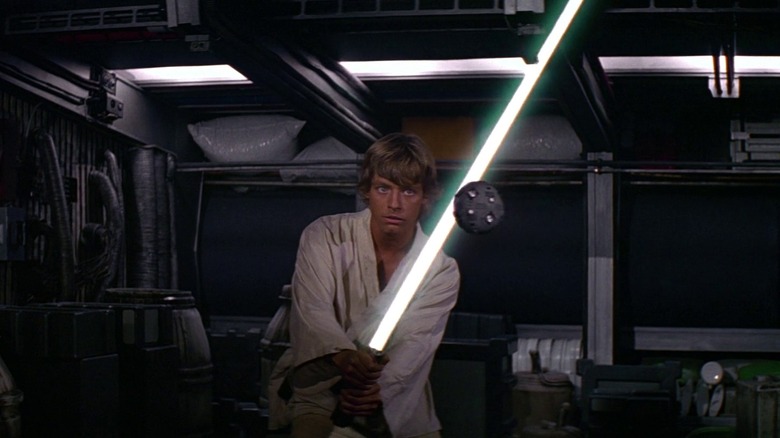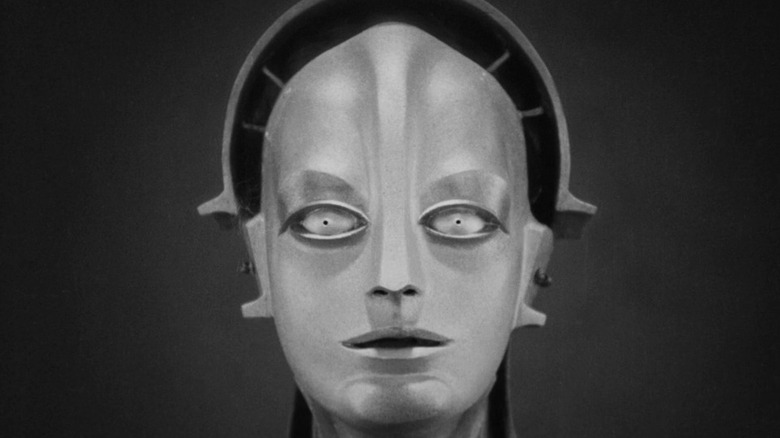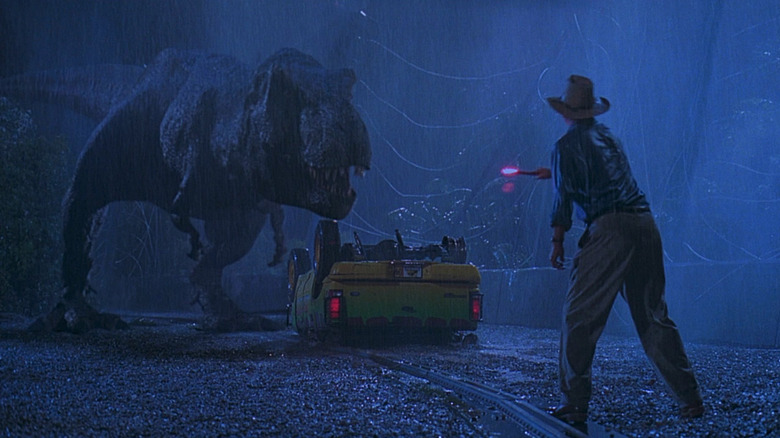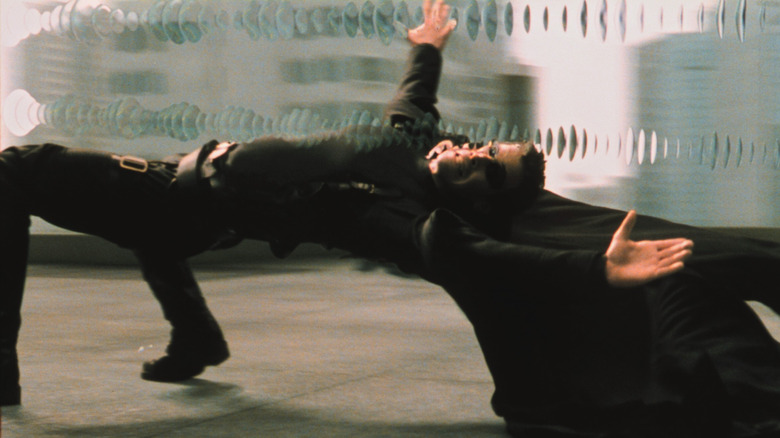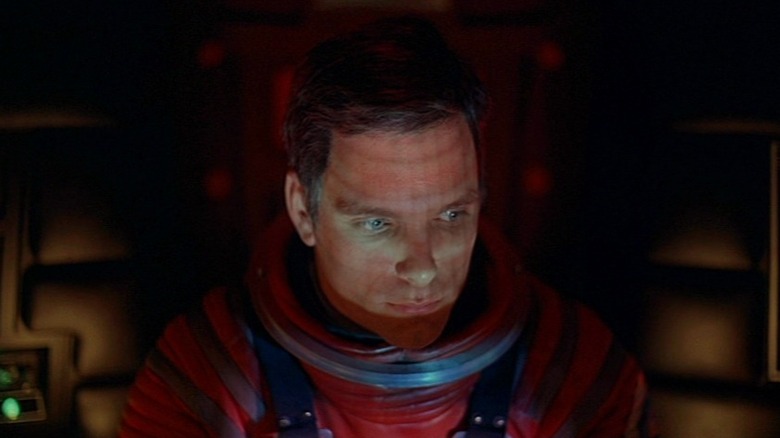10 Most Ambitious Sci-Fi Movies Of All Time, Ranked
Every film genre is essential to the human experience. Comedies allow us to de-stress, horror movies make us confront our deepest fears, and documentaries educate us. But when it comes to the overall enrichment of filmmaking technology, no genre is as crucial as science-fiction.
The best sci-fi movies ever cover a range of topics. They take us to new planets or showcase some kind of fantastical technology that's perhaps harboring some dark secret. Whereas comedies and thrillers tend to take place in the real world, sci-fi stories often require developing something entirely new that audiences haven't seen before. To accomplish this, filmmaker may need to develop an entirely new technology in the real world to make their vision come to life.
Ambition isn't always about creating a new advancement in CGI either. Sometimes, a filmmaker wants to tell an incredibly powerful story, one that had never really been done on the big screen before and finds pure movie magic. The most ambitious sci-fi movies of all time aren't just great in their own rights; they've influenced generations of films that followed them.
Here are what we feel are the most ambitious sci-fi movies of all time.
10. Avatar
"It looks amazing, but it's just 'Pocahontas.'" "Avatar" deserves much better descriptors than what most folks online are willing to give it. The story is, indeed, familiar, but that was likely writer/director James Cameron's attempt to get audiences adjusted to the bold new world of Pandora where humans are attempting to extract the rare mineral of unobtainium from the planet while maintaining relations with the native Na'vi.
3D technology had never looked better. It had existed in movies before but mostly as a gimmick with something jumping out at viewers. "Avatar" simply immerses you in the world where you may not even notice some alien flower seemingly floating near your face. It helped kick off a 3D resurgence of other movies adopting the technology, even if it led to diminishing returns. There's also the exceptional motion-capture technology for the performers turned into Na'vi. Again, this is something the world had seen before with digital creations like Jar Jar Binks (Ahmed Best), but there was always a risk of the creation appearing too cartoony. Neytiri (Zoe Saldaña) and the other Na'vi don't look out of place next to their human co-stars.
While the first movie's story is nothing to write home about, Cameron has embarked on a cinematic odyssey, planning a far-spanning franchise for this world. He didn't rest on his laurels for "Avatar: The Way of Water," creating stellar visual effects to make all of the water scenes look cinematic. Cameron has several more "Avatar" movies planned, and if each one enhances film tech in some way, the series will leave behind an indelible legacy, even if it is just "Pocahontas" with blue cat people.
9. Tron
These days, it's common to see movies where everything seems to be fully CGI or at least contains a green screen backdrop. However, back in 1982, "Tron" pioneered the use of early CGI. There are about 15 minutes of entirely CGI sequences within the movie, which doesn't sound like a lot these days but was radical at the time of release. The movie may seem quaint by today's standards, but make no mistake, it paved the way for future filmmakers to incorporate the new technology more extensively in their own works. Former Pixar CCO John Lasseter has even stated how there'd be no "Toy Story" without "Tron."
What makes "Tron" a visual marvel to this day is how it incorporates standard CGI with practical effects. For instance, "Tron" uses backlit animation by shining a colored light source through a cut-out portion of sets or costumes to give everything a vibrant neon glow. Humorously, "Tron" would get disqualified from the Visual Effects Oscar at that year's ceremony, since the heavy usage of computers was deemed cheating.
"Tron" only made about $33 million at the box office, but its continued existence in the zeitgeist is a testament to what it accomplished. "Tron: Legacy" would follow in 2010 and similarly become more of a cult hit in the years that followed. "Tron" remains a staple in pop culture because each installment pushes the boundaries of what's possible with CGI. Sometimes, the world just needs time to realize what it has...
8. The Abyss
James Cameron actually wrote "Avatar" in 1995 but had to wait for technology to catch up with his vision of how the film could look like. But that didn't mean he was just sitting around with the technology at his disposal. He continued spearheading new ways to tell fascinating stories, like with 1989's "The Abyss," which sees a team attempt to retrieve the payload of a sunken American submarine and wind up encountering an alien species deep within the ocean's depths.
"The Abyss" was a daunting shoot for its cast and crew, as it required people to be submerged in water for hours at a time. To get the look of a submarine moving deep within the sea, the team built a quarter-scale model that was controlled via a radio. But arguably, the most impressive effect everyone remembers is the alien water tentacle that reaches out to touch Bud (Ed Harris) and Lindsey (Mary Elizabeth Mastrantonio). Industrial Light & Magic accomplished much through practical means, and the actors' faces were digitally scanned for when the tentacle mimics their appearances. CGI was incorporated for when the tentacle transforms back into water, and while it was an arduous process, it's an effect that holds up to this day.
Shooting "The Abyss" nearly killed Cameron, but pushing the limits of what's possible with film seems to be par the course for him. The movie helped make water-based CGI creations more mainstream, like the liquid metal effect used in another Cameron project, "Terminator 2: Judgment Day." Without a visionary like Cameron pushing for more realistic digital effects, it's possible it would've taken much longer for future sci-fi movies to adopt them.
7. Gravity
In the aftermath of "Avatar," many movies tried to capitalize on the newfound 3D trend, but arguably, no other film used it as well as 2013's "Gravity," directed by Alfonso Cuarón. Whereas "Avatar" used 3D to immerse audiences in Pandora, "Gravity" uses it to instill a deep sense of dread and fear. The film opens with an uninterrupted 20-minute sequence where we're introduced to our astronauts and witness debris take out their shuttle, sending Dr. Ryan Stone (Sandra Bullock) on a mission to get out of space with her life.
It's a classic survival story but told in an environment with no gravity where everything seems to be working against Dr. Stone. Naturally, they didn't actually send the actors into space, so they had to bring space down to Earth, with many shots being entirely CGI except for the actors' faces. Bullock and George Clooney would be surrounded by over a million LED lights to simulate the actual casting of shadows one would find in space. This would go on to serve as the basis for The Volume, which would create artificial environments on projects like "The Mandalorian" and "The Batman."
When most people think of advancements in CGI, they think of characters like the Na'vi or the Terminator. But "Gravity" set the stage for their to be greater fidelity within creating artificial environments. It's not enough for people to look right but for audiences not to get distracted by something looking wonky in the background.
6. Interstellar
What makes "Interstellar" stand out among other ambitious sci-fi movies is how strongly it adhered to real science. This is mostly due to physicist Kip Thorne serving as the film's consultant and ensuring all scientific concepts are portrayed as accurately as possible. For example, the black hole Gargantua was designed using equations developed by Thorne, ensuring there are accurate aspects like gravitational lensing present. Even the scientific concepts researchers are still unsure about, like how exactly a wormhole would operate, are still grounded in what we do know, as the film's wormhole is grounded in Albert Einstein's theory of general relativity.
All of this is well and good, but "Interstellar" incorporates these scientific concepts with a grounded, human story of a father, Coop (Matthew McConaughey), searching for a new home for his children to live and thrive in. "Interstellar" is more than mere popcorn entertainment; it's a call to action that humanity has only scratched the surface of what we're capable of, and there's so much more left out there for us to discover.
"Interstellar" is also a crucial stepping stone in director Christopher Nolan's utilization of IMAX cameras. It's a film format he's toyed with before in "The Dark Knight" trilogy, and "Interstellar" used them even more. It's now gotten to the point where Nolan has gone all in on the technology to the point where "The Odyssey" will be the first blockbuster movie filmed entirely with this tech.
5. Star Wars
"Star Wars" is ubiquitous now, but there was a time when uncertainty loomed about whether anyone would care about some random space opera. Of course, the world fully embraced George Lucas' vision. It was an unparalleled success, bringing science fiction more into the mainstream with the movie's unprecedented special effects. "Star Wars" expertly blends practical effects with new technology from Industrial Light & Magic, going over-budget in the process but making the idea of a laser sword look actually feasible.
Even something as seemingly simple as the opening text crawl providing background to the story has an impressive story behind it, with a camera on a special rig moving so that it looked as though the words themselves were flying upward. But perhaps the most astonishing thing "Star Wars" achieved was its world-building. Lines referring to the "Clone Wars" may seem like Easter eggs today, but when "Star Wars" first came out in 1977, it was merely a hint at what could've been.
People's imaginations were lit aflame of what other stories could be told in this expansive universe. "Star Wars" may be science fiction, but its world felt as immersive as any fantasy work, like "The Lord of the Rings." The fact that so many "Star Wars" movies, TV shows, novels, and comic books have emerged in the decades since is a testament to the awe and wonder Lucas managed to achieve in that first film.
4. Metropolis
Creating digital environments and characters may seem like old hat today, but there's still something positively wondrous about what Fritz Lang was able to achieve with 1927's "Metropolis" before any of those technologies were available. "Metropolis" was extremely ambitious for its time period, as it includes massive sets and large swaths of extras to fill out the cast. In fact, many techniques still used in films today originated (or were at least popularized) by "Metropolis," such as the utilization of miniatures.
It wasn't enough merely to have miniatures. The movie's effects expert, Eugen Schüfftan, pioneered what would become known as the Schüfftan process, which is when mirrors are used to make it look like full-size human beings are able to occupy the miniature sets. It's a technique that would be adopted by Alfred Hitchcock on his 1929 film "Blackmail."
In the nearly century since "Metropolis" came out, it's easy to see how it's influenced all kinds of other films. The Maschinenmensch (android) must've surely played a part in inspiring the design of C-3P0 from "Star Wars," and the German expressionist designs of the architecture paved the way for the aesthetics of Tim Burton's "Batman" movies and "Blade Runner." H.G. Wells may have hated "Metropolis," but science fiction simply wouldn't look and feel the same if the film never existed.
3. Jurassic Park
Moviegoers will go to the movie theater to witness stunning virtual environments and characters, but too much of a good thing can have negative consequences. If something doesn't quite look real, it opens the floodgates to criticism. And yet, decades after it first came out, there's nothing really to pick apart with the original "Jurassic Park" film, as the dinosaurs look as good today as they did back in 1993. It's almost astonishing how these animals look better using technology from the 1990s compared to how they look in later installments of the same franchise, but it's a testament to how well things look when production teams combine practical with visual effects rather than solely relying on digital.
Amazingly, "Jurassic Park" only has about 15 minutes of screen time for the dinosaurs, of which six contain digital renderings. The film has managed to persist in the public consciousness thanks to what it has to say about unchecked egotism and pursuing science without a clear understanding of the ramifications. While sequels were more than content to focus on dino-rampaging, "Jurassic Park" takes its time getting there, providing audiences with scenes of people sitting around talking about whether man has a place to play God.
"Jurassic Park" is truly timeless. These conversations surrounding new technologies are still worth having today, and it broke new ground for how production crews could combine the real with digital, even in the same frame, to create something that doesn't age a day.
2. The Matrix
It truly feels like a miracle that a major studio would've greenlit something like "The Matrix." There was certainly some hesitancy, as Warner Bros. was reluctant to sign off on the film, so Lana and Lilly Wachowski developed 600 storyboards to plan out every single shot so that the higher-ups could visualize exactly what the finished product would be. Knowing exactly what shots to get was undoubtedly a major asset once production began, and the film crew developed new techniques, most notably "bullet time," which entailed placing a rig of cameras around Neo (Keanu Reeves) and then using digital compositing to make it look as though a single camera were moving around him. It's an incredible sequence that's been parodied to death for good reason; it looks unlike anything that has come before.
But creating the sci-fi world of "The Matrix" didn't just involve using a lot of fancy technologies. There was also the matter of "The Matrix" drawing from anime, particularly "Ghost in the Shell," which was still trying to find a foothold amongst Western audiences in the '90s. It's a philosophically rich film that explores concepts related to free will, and the Wachowskis wanted the franchise to change the way audiences engage with media, encouraging viewers to find their own meaning within something like "Matrix: Revolutions."
"The Matrix" is such a thematically rich film that it continues to inspire discussion to this day, with more people forming discussions around how the film functions as an allegory for the trans experience. In the future, "The Matrix" will likely only become even more critical as we continue searching for answers within an increasingly digital world.
1. 2001: A Space Odyssey
Few films, science fiction or otherwise, are ambitious on the scale of "2001: A Space Odyssey," but cinephiles would expect nothing less from Stanley Kubrick. Indeed, it's a vast odyssey examining humanity's place in the cosmos, opening with a scene of our ape ancestors before transitioning into a space expedition that goes awry from H.A.L. (voiced by Douglas Rain), an artificial intelligence turned malevolent. All of this is achieved through the use of long takes and minimal dialogue. Classical music accompanies scenes instead of lofty paragraphs of exposition, forcing the audience to engage with the text on a deep, primal level to determine what's happening.
Perhaps that's why audiences and critics had a brutal reaction to "2001" when it first came out, but time has definitely been kind. The movie's a visual splendor to behold, with incredible shots like the "star gate" sequence. This particular shot utilized a new slit-scan technique that shot the same sequence repeatedly to develop otherworldy visuals.
Despite coming out in 1968, "2001" could be seen as predicting future technologies, like a video calling system not unlike Zoom today. Naturally, the prediction that remains to be seen as whether it comes to fruition is whether AI can become even more intelligent than humans. With AI being everywhere nowadays, "2001" becomes even more deserving of rewatches. "2001: A Space Odyssey" peered into future, combining new film techniques and classic philosophical concepts to develop something wholly its own that inspired pretty much any film set in space that has come out since.
